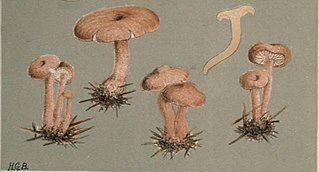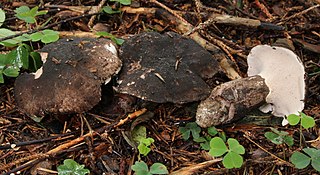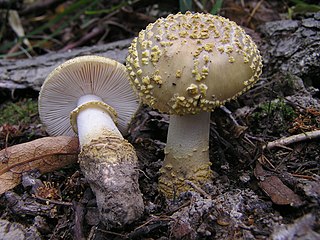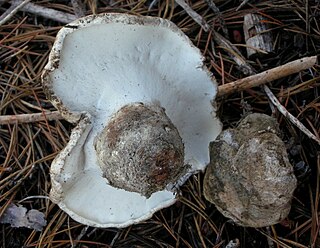
Suillus luteus is a bolete fungus, and the type species of the genus Suillus. A common fungus native all across Eurasia from Ireland to Korea, it has been introduced widely elsewhere, including North and South America, southern Africa, Australia and New Zealand. Commonly referred to as slippery jack or sticky bun in English-speaking countries, its names refer to the brown cap, which is characteristically slimy in wet conditions. The fungus, initially described as Boletus luteus by Carl Linnaeus in 1753, is now classified in a different fungus family as well as genus. Suillus luteus is edible, though not as highly regarded as other bolete mushrooms. It is commonly prepared and eaten in soups, stews or fried dishes. The slime coating, however, may cause indigestion if not removed before eating. It is often sold as a dried mushroom.

Pleurotus dryinus, commonly known as the veiled oyster mushroom, is a species of fungus in the family Pleurotaceae. It grows on dead wood and is also a weak pathogen; infecting especially broad-leaved trees.

Armillaria socialis is a species of fungus in the family Physalacriaceae. It is a plant pathogen. Originally described by Augustin Pyramus de Candolle in 1815, it was transferred to Armillaria by Victor Fayod in 1889. It is found in Asia, Europe, and North America.

Helvella is a genus of ascomycete fungus of the family Helvellaceae. The mushrooms, commonly known as elfin saddles, are identified by their irregularly shaped caps, fluted stems, and fuzzy undersurfaces. They are found in North America and in Europe. Well known species include the whitish H. crispa and the grey H. lacunosa. They have been reported to cause gastrointestinal symptoms when eaten raw.

Boletopsis is a genus of mycorrhizal fungi in the family Bankeraceae. The genus was circumscribed by Swiss mycologist Victor Fayod in 1889, with Boletopsis leucomelaena as the type species.

Hebeloma radicosum, commonly known as the rooting poison pie, is a species of agaric fungus in the family Hymenogastraceae. Fruit bodies (mushrooms) can be identified by the tapering root-like stipe base, as well as the almond-like odor.

Helvella acetabulum is a species of fungus in the family Helvellaceae, order Pezizales. This relatively large cup-shaped fungus is characterized by a tan fruit body with prominent branching ribs resembling a cabbage leaf; for this reason it is commonly known as the cabbage leaf Helvella. Other colloquial names include the vinegar cup and the brown ribbed elfin cup. The fruit bodies reaches dimensions of 8 centimetres (3 in) by 4 cm tall. It is found in Eurasia and North America, where it grows in sandy soils, under both coniferous and deciduous trees.

Dissingia leucomelaena, commonly known as the white-footed elf cup, is a species of fungus in the family Helvellaceae of the order Pezizales. As its common name implies, it is characterized by the white coloring of its stem.
Victor Fayod was a Swiss mycologist, who created an influential novel classification of the agaric fungi and who described a number of new genera and species.

Cystoderma carcharias, is a species of agaric in the fungal family Agaricaceae. It has a widespread distribution, and has been collected in coniferous forests and grasslands in Asia, Europe, North America, and the subantarctic islands. In the field, fruit bodies are characterized by a pink cap up to 6 cm (2.4 in) broad, a well-developed ring on the stem, and an unpleasant odour.

Amanita franchetii, also known as the yellow veiled amanita, or Franchet's amanita, is a species of fungus in the family Amanitaceae.

Septobasidium is a fungal genus within the family Septobasidiaceae. Approximately 175 described species are associated with this genus. 227 records are listed by Species Fungorum.

Hydnellum ferrugineum, commonly known as the mealy tooth or the reddish-brown corky spine fungus, is a species of tooth fungus in the family Bankeraceae. A widely distributed species, it is found in north Africa, Asia, Europe, and North America. The fungus fruits on the ground singly or in clusters in conifer forest, usually in poor or sandy soil. Fruit bodies are somewhat top-shaped, measuring 3–10 cm (1–4 in) in diameter. Their velvety surfaces, initially white to pink, sometimes exude drops of red liquid. The lower surface of the fruit body features white to reddish-brown spines up to 6 mm long. Mature fruit bodies become dark reddish brown in color, and are then difficult to distinguish from other similar Hydnellum species. H. ferrugineum forms a mat of mycelia in the humus and upper soil where it grows. The presence of the fungus changes the characteristics of the soil, making it more podzolized.

Agrocybe praecox, commonly known as the spring fieldcap, spring agrocybe or early agrocybe, is a species of brown-spored mushroom which appears early in the year in woods, gardens and fields. According to modern taxonomic analysis, it is just one of a cluster of closely similar species which are often referred to as the Agrocybe praecox complex. It is found in Europe, North Africa and North America.
Corneroporus is a fungal genus in the family Bankeraceae. It is monotypic, containing the single species Corneroporus subcitrinus, found in Malaysia. This fungus was originally described in the genus Boletopsis by mycologist E. J. H. Corner in 1989.

Boletopsis nothofagi is a fungus in the family Bankeraceae. The fungus forms grey fruit bodies that grow in clusters. Like all species of Boletopsis, it has a porous spore-bearing surface on the underside of the cap, but differs from other species of Boletopsis by having characteristics such as elongated spores and a green discoloration when stained with potassium hydroxide. Boletopsis nothofagi is endemic to New Zealand and has a mycorrhizal association with red beech. It is unknown when exactly the fungus forms its fruit body, but it has so far been found solely in May, during autumn in the Southern Hemisphere.

Boletopsis grisea is a species of fungus in the family Bankeraceae. The fruit bodies are gray, fleshy polypores that grow on the ground in a mycorrhizal association with Scots pine. It is found in Asia, North America, and Europe.
Conocybe moseri is a mushroom species in the family Bolbitiaceae. It was described as new to science in 1980 by mycologist Roy Watling, from collections made in France. The specific epithet moseri honours Austrian mycologist Meinhard Moser. The fungus has been reported from the United Kingdom, growing in grassy areas, fields, and edges of woods. In 1995, it was recorded from Switzerland, from Ukraine in 2007, and from Russia in 2007. It was reported from India in 2015, where it was found growing on cattle dung.
Boletopsis atrata is a species of hydnoid fungus in the family Bankeraceae. It was described as new to science in 1982 by Norwegian mycologist Leif Ryvarden. It has a disjunct distribution, found in temperate forests of East Asia and Eastern North America, where it fruits at the base of hardwood trees and stumps, especially oak (Quercus) and chestnuts (Castanea).
Boletopsis smithii is a species of hydnoid fungus in the family Bankeraceae. It was described as new to science in 1975 by mycologist Keith A. Harrison, from collections made in Washington.















